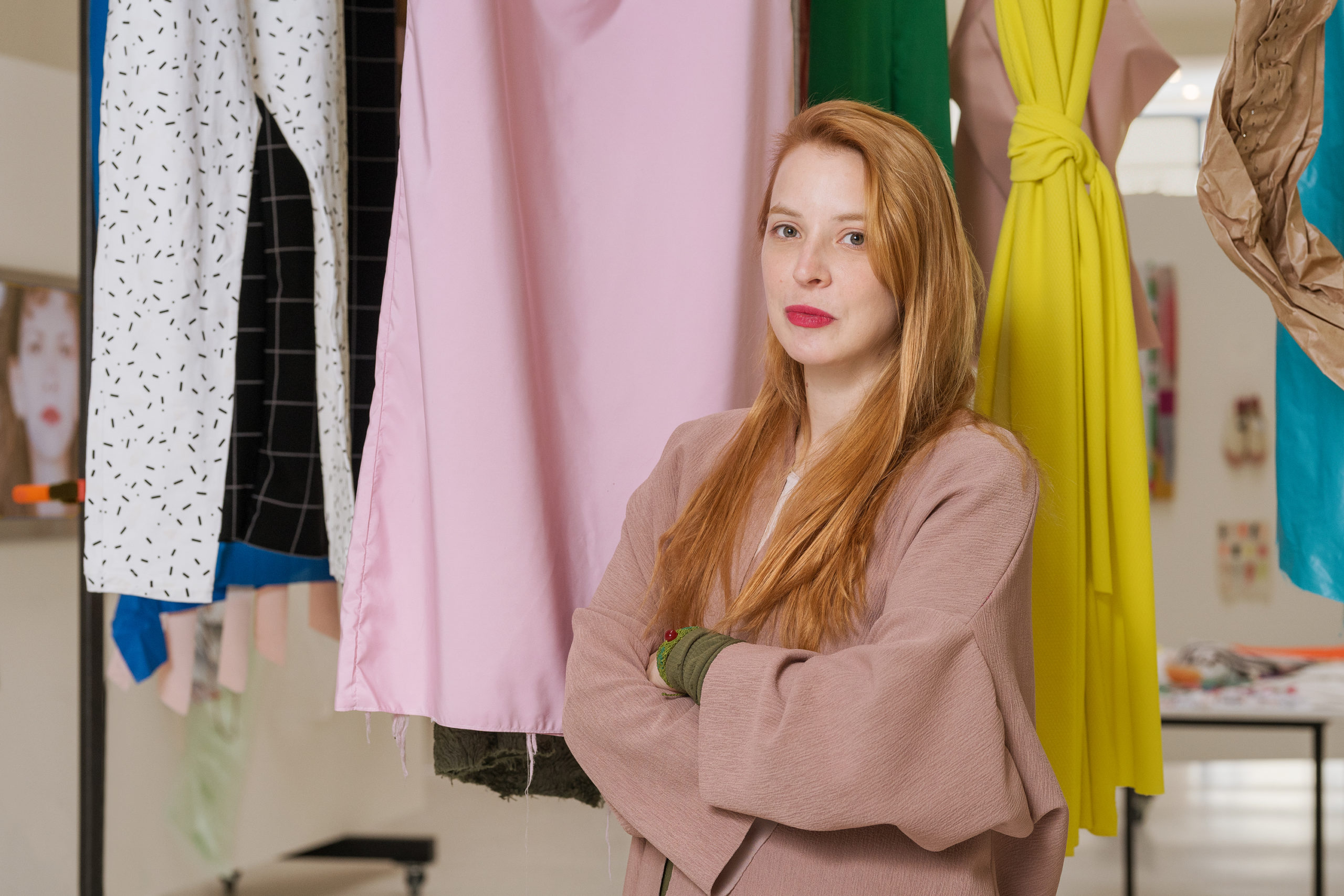
Photo: archive National Gallery in Prague
Romana Drdova is a Czech artist whose works borders on the lines of fine art, fashion, and design as it engages with themes of perception and human interaction in a time of “data smog.” Graduating from the Academy of Fine Arts in Prague in 2017, she’s gone on to solo exhibitions at Czech institutions MeetFactory and Karlin Studios, along with international presence in Vienna, Berlin, and Liege, Belgium. Her project “Mapo Tofu Masks: An Asian Love Story” was published in issue #25 of zingmagazine. Most recently, Drdova’s work is being exhibited at the National Gallery in Prague, curated by Adéla Janíčková as part of The Empathy Award, on view through February 2, 2022.
Interview by Lenka Bakes
In your first interview for zingmagazine (2019) you spoke about drawing inspiration from Korean culture, the bond you’ve made to China as well as the impressions you picked up during your time in New York. It’s obvious you keep a close eye on various cultural practices and they inspire you in your work, which you’ve described as a “spiritual translator”. This practice led you to create your first series facemasks, which zingmagazine published in New York at the beginning of 2018.
I’d like to ask what has changed in your professional life? Where have you drawn your inspiration from and what has interested you during these past two pandemic years? Have you created another collection of masks? What was the impulse behind facemasks back then? Did the masks resonate with people and in public space, which was affected by the pandemic for much longer than we expected?
Much has changed since society has changed and is still changing as a result of the pandemic. My main shift has been in realizing the quality of time I want to devote to self-realization. I’ve discovered that this is the only way I can work in society and do something for it, it’s also the only case in which I’m at peace with myself.
My work with facemasks, which I started creating in 2017 and was published by zingmagazine, had the character of an unusual fashion accessory. Today, face masks have become an essential part of everyday life. For the new collections, I used themes dealing with the segregation that the pandemic has brought on a large scale.
During the past two years the boundary between one’s inner and outer world and the individual and their surroundings has deepened. You often articulate relationships in your work or visualize their absence. This makes me feel that you may be interested in this boundary. Have you experienced something like this personally?
The gap between what we feel internally and how we act or look in society is alarming. The pressure that brings the suppression of achievement is a disease of society. I’ve always been interested in the surrounding world and its method of communication. In several exhibitions my work was concerned with how visuality or barriers form our bodies and mind. For example, at the Futura Center of Contemporary Arts I created a city light billboard where sexual and romantic motifs were featured along with seductive images. My intention here was to create a scan of my own thoughts, what I’m really thinking about when I’m waiting at a tram or bus stop.
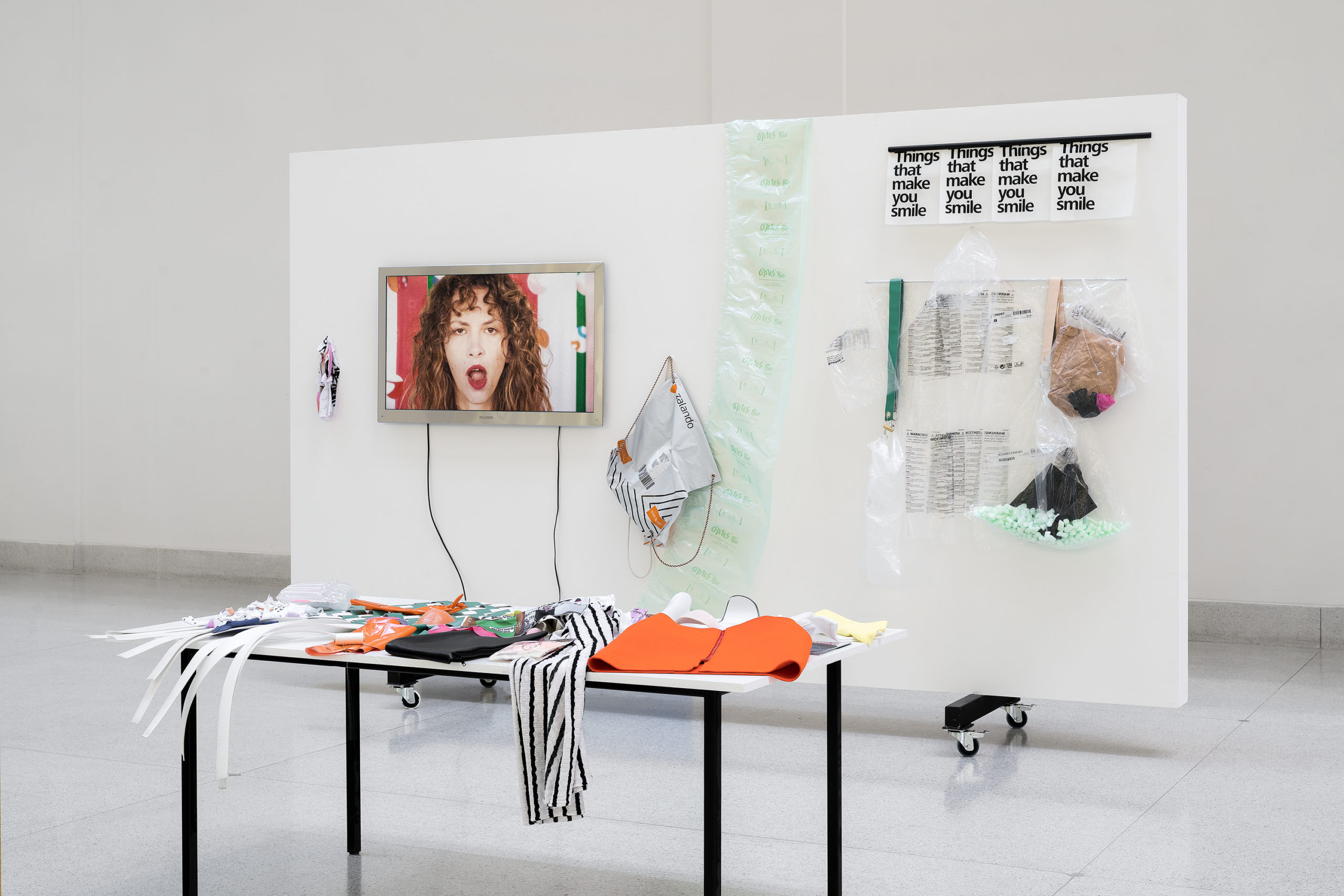
Photo: archive National Gallery in Prague
If we zoom in on interpersonal relationships, we can return to the work you first presented last autumn at the group show The Unremarkableness of Disobedient Desire, put on by the Lucie Drdova Gallery. Here you presented a series of “haute-couture” silk scarves imprinted with sexual motifs, playful faces or unchaste inscriptions such as symbols of the fetishization of the female body, power, fetish and phallic elements. Could you tell us more about how and why this series came about?
This series was created as an imprint of a time that I went through in a lover’s relationship. I could call it a relief of emotions, imprints that appeared within me. Now that some time has passed I can see how essential this relationship was for my personal development. At the time I was concerned with the theme of power, which relationships often have over us. I wondered how women are situated in society and this naturally led me to feminism and books where I searched for answers to my questions. The scarves were created as my hope that I and other women will break the staff of patriarchy which has historically been rooted within us. I decided to use scarves because they represent a luxurious item that men offer women in return for their company. These scarves however are given by women to women as a manifesto of sisterhood and solidarity. This work also opened up a new perspective for me on masculinity, which is just as fragile as femininity.
Has a transformation taken place in your case? What has helped you along your way? Do you have any idea what awaits you?
I think that I can call the last two years transformational, not only from the viewpoint of the general paradigm of changes in society, but also from an inner perspective. Taking time to stop and reflect, stays in nature and self education are essential in allowing one to withstand the storms moving our planet. Now I’m focusing on female sexuality which has led me to start writing poetry, something I am really enjoying at the moment.
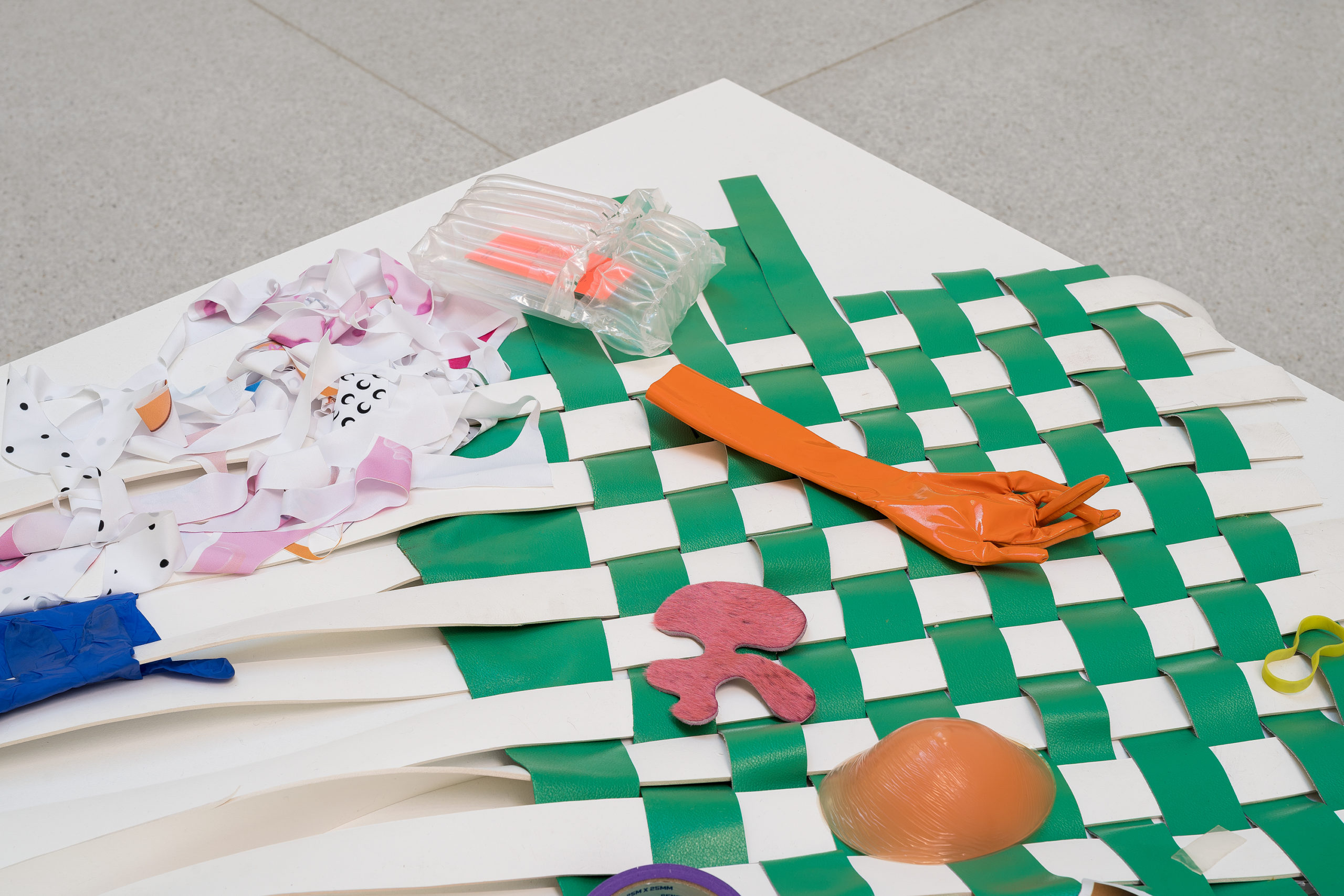
Photo: archive National Gallery in Prague
I like the parallel of this work as it relates to the relationship between men and women in general. Even in today’s generation women must come to terms with the consequences of historical pressure and unhealthy relationships with men. Have you gone further with this motif in your work? How do you view the role of women and women artists in society today?
Relationships are like a mirror for me. They reflect society’s overall stance. It’s fascinating to observe and be able to work with this theme which, in my opinion, is inexhaustible. These days women are taking the reins. It’s a challenge that we should meet with the vision that the patriarchy has made its own mistakes which we should not repeat. Our task is to put aside the ego and see beyond the boundaries of one’s own gender. Collaboration is one possibility to healing the cracks of our civilization and giving it a chance of resuscitation.
As women, mothers, partners, etc. we should bring principles into society that connect matriarchy and patriarchy on an equal level. As an artist I sometimes feel like an endangered species that must simultaneously be incredibly resilient to survive. This requires a combination of a high level of sensitivity and introversion that must, at a certain moment, transform itself into extroversion in order for my work to be visible.
There’s a currently ongoing exhibition at the National Gallery in Prague as part of the Empathy Award. What can be seen at this exhibition? Did part of this series come about in New York? Could you tell us more?
This exhibition concerns itself with recycling and upcycling and it’s true that I had my first impulse towards it thanks to an artist residency in New York. When I visited the Material for the Arts Organization in 2018 I was overcome by the site and donation work. In my own practice I’ve always been very focused on materials and taken pleasure in discovering previously unknown ones, as I did during my stays in Korea and China. This project, which I worked on for two years, has combined my interest in fashion and creating my own collection out of unwanted material. In the installation you can also see my work environment. At the same time that the exhibition was opening in Prague, there was also an opening in the Below Grand Gallery, where I collaborated with the Berlinskej Model Gallery, that is with you and Richard Bakes. In this group exhibition entitled Holy Matter, I exhibited a latex top and latex panties from the latest works.
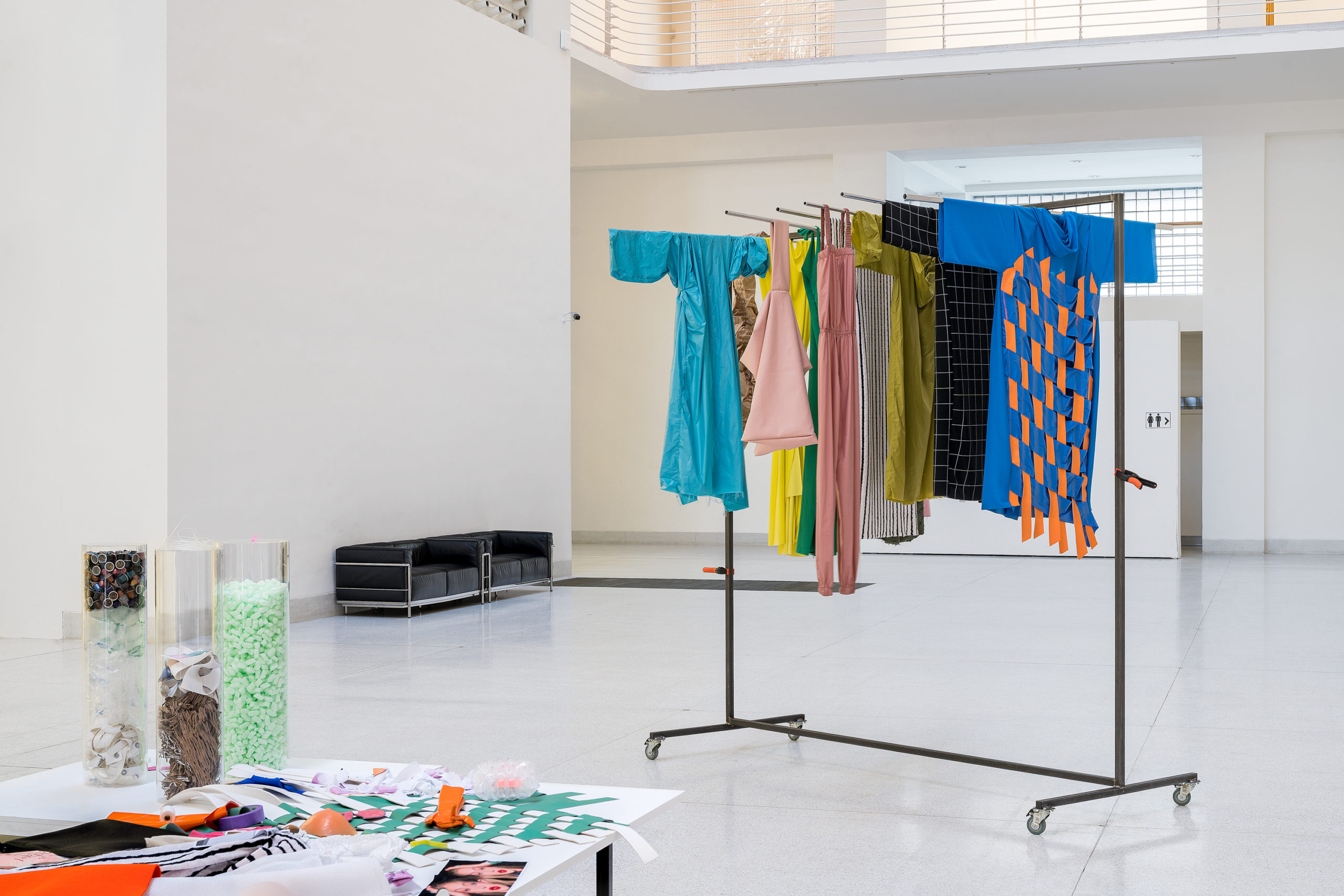
Photo: archive National Gallery in Prague
The exhibition State of Matter speaks to your fascination with material and upcycling. Now you’ve created your own physical and online platform as a way to house and explore this fascination. Could you tell us a bit more about that?
Yes, I’m currently preparing for the next step in my work, that is creating my own fashion label that’ll be on the border of art and design. Right now I’m working on an online platform that’ll be as user friendly and comprehensible as possible. One thing’s for certain, the name of the label will be “Votre Dick,” which was one of the central motifs of my scarves and the impulse behind continuing to explore this topic.
Most of your work is characterized by its use of upcycling materials. Is this an intention in which you battle yourself and the world or does it just happen naturally?
It comes naturally as a result of my own situation and sense of kindness towards my surroundings. I always consider the priorities when deciding what material to work with. I don’t want to continue to consume more and more things. I want the work that I do to alert others to the fact that we as humanity no longer have run out of time, which can’t be bought. By not recycling or surrounding ourselves with piles of garbage we only clog our own conscience by not acting with love towards nature or ourselves, becoming merely traumatized victims of our own existence.
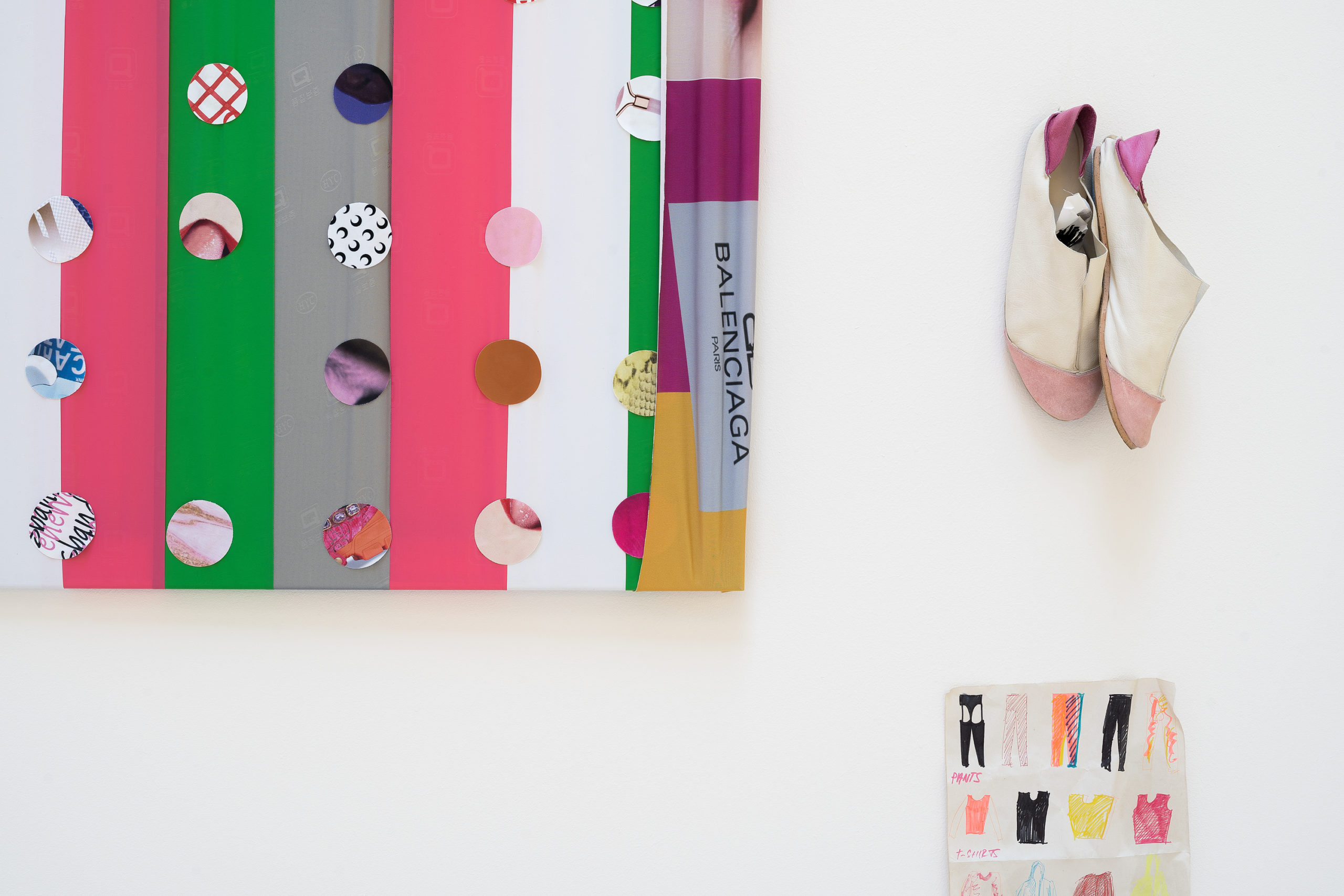
Photo: archive National Gallery in Prague
This project is a good illustration of another level in your work, that is an interest in design and fashion. In this case, radical fashion. Could you explain this concept? Do you also practice radical fashion in your own closet? Tell us where you buy most of your pieces and which of them you like the most.
I try to keep my closet within parameters that I can oversee. I often think about fashion and what it means. Fashion is a reflection of the mental state, it is a communication with one’s surroundings and often makes up our first impression of a person, how they’ve fixed themselves up, what they’re wearing, etc. Radical fashion doesn’t cling to having plenty of everything. It’s about the feeling of being yourself in what you’re wearing, which is a part of your identity. It’s an expression I can articulate without speaking, just through what I’m wearing. The fact that I sew my own clothes is a way of communicating, telling the world outright what’s important to me. Most often I buy Camper shoes, Rains clothing and I adore the creative shoe company Simona Vanth and many others. In my own closet I prefer jumpsuits and kimonos with which you can create many variations and which are made up of surprising materials.
For more:
http://www.romanadrdova.com/
@romanadrdova
@lenkawallon
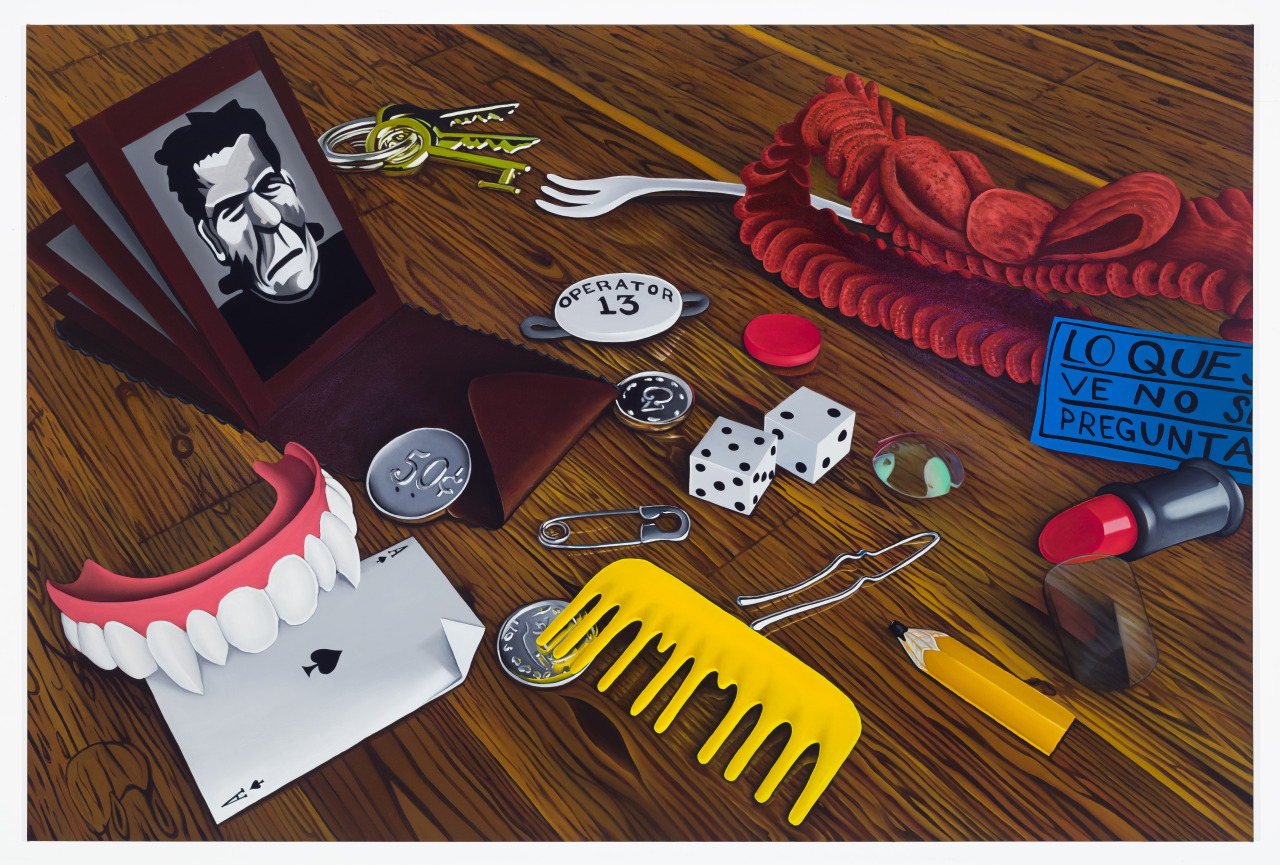
Edgar Serrano, I am an Enigma, Even to Myself, 2021, 48 x 72 inches, Oil on canvas
Edgar Serrano is a painter whose work integrates a range of visual aesthetics, iconography, and even materials, dissolving unstable borders between popular culture and fine art, analog and digital, self and “other,” while challenging xenophobia and reductive representation through appropriation and complexity. Born and raised in Chicago, he now lives and works in New Haven, CT where he earned an MFA in painting and printmaking from Yale University School of Art. His solo show Rumors of My Demise is the inaugural exhibition at Brief Histories’ new space on the Bowery in New York. Rumors of My Demise runs through January 8, 2022.
Interview by Brandon Johnson
Where are you from, where do you live now, and how has your environment affected your work?
I am originally from the west side of Chicago and lived there until 2008 when I went away to graduate school. After graduate school I lived in Brooklyn for a few years doing art residencies and trying to maintain a studio practice. The stimulating thing about Brooklyn was how everything was mixed up, different ethnicities, different cultures, different perspectives all interwoven and in tatters but beautiful, nonetheless. This is vastly different than the environment I grew up in Chicago where the city itself is designed to keep everyone segregated, isolated, and in place.
I currently live and work in New Haven, Connecticut. Connecticut is interesting because it prides itself in being socially progressive and inclusive environment. From my experience it’s also very segregated but in this invisible and unspoken way. I grew up amongst unseen but ever-present borders that have sharpened my senses and shape my practice. Looking into different worlds, either through art history, or Saturday morning cartoons, to wider political, economic, and societal issues I am drawn to the borders and peripheries dividing these worlds.
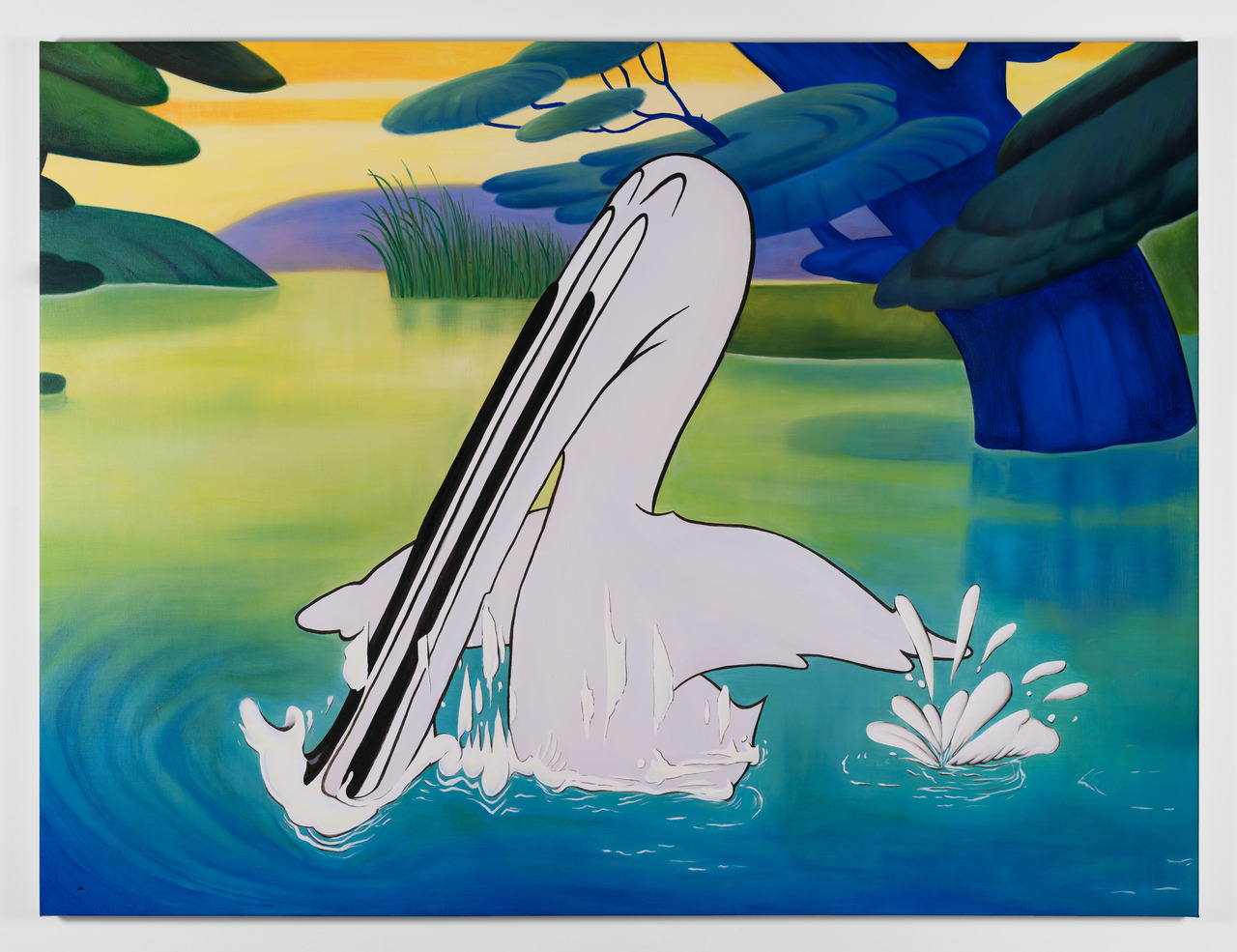
Edgar Serrano, Eternal Artifice, 2018, 46 x 61 inches, Oil on canvas
Could you speak on how these borders and peripheries manifest in your paintings, whether in terms process, form, and/or subject? For example works like “Eternal Artifice” appear to be in a moment of flux or transition…
Recently, I’ve been interested in the hand drawn “animation smear” which depicts one quick blur of motion in a single frame and the illusion of movement found in cartoons from the Golden Age of American Animation (1920s-60s). By using video editing software, I can analyze video files frame-by-frame, isolating and excavating normally invisible moments of transition or blur.
“Eternal Artifice” for example was initially excavated from various childhood cartoon sources using my personal archive of VHS tapes and video editing software. Resulting in images that are both familiar and strange, showing well-known cartoon characters in states of transition that are usually undetectable to the human eye. Due to the speed of film and the sequential duration of these short states of transition.
In my research I found that these in-between “blur or transitional” movements in cartoons from my childhood, mirrored my own trauma of not knowing English initially as the son of Mexican immigrants and that of migrant children in detention centers. The blur acting as a state of being caught in-between two realities, flux, or a limbo state. My relationship to these images is both symbolic and contains a dark narrative subtext.
A few of your paintings, such as “I am an Enigma, Even to Myself,” “The Sun Doesn’t Set It Just Goes Away,” and “Encyclopedia of Invisibility” include a Frankenstein-esque figure or silhouette. Is this a self-portrait of sorts? How do you relate to this misunderstood “monster”?
I sometimes evoke the tropes and aesthetics of villains and monsters as a metaphor for marginalized identities. Cartoon monsters as abstract representations of how people might perceive me or others that resemble me. For example, the werewolf, the intruder, or the Frankenstein monster, operate as proxies. The Frankenstein monster in particular is a monster with compassion and who also suffers from a complex identity. Feeling misunderstood, he causes fear due to his appearance, and that same fear makes him afraid. This sentiment is mirrored in the social realities of contemporary America: the fear of the unknown and xenophobia. As we know through great literature and perhaps in art, humanity’s irrational perceptions and fear are the true monsters.
In your younger years, your visual influences were cartoons, album covers, and magazines. Since entering the formal world of fine art, what have been your more recent visual influences?
I am still interested in imagery grounded in reproductions, like cartoons, postcards, and comics. But I am also clearly interested in and responding to the political and social context around me.
Some of my visual influences range from postwar/contemporary German artists who moved from abstraction to figuration in a new way like Gerhard Richter, Sigmar Polke, Albert Oehlen, and Georg Herold.
Recently I’ve also become attentive to the inadequacy of abstraction to clearly delineate meaning, which leaves room for a fresh perspective and to make new meaning. Some of the other artists that I see as exploring this territory are American abstract artists like Rochelle Feinstein, Mary Heilmann, and Jessica Stockholder. This inadequacy leaves the door open for invention and opportunity in painting, which appeals to me.
I am also invested in Carroll Dunham’s work. As I see it, he disregards the boundaries between high and low art and gathers diverse vocabularies into one picture frame to create immediacy and impact. Ideas and feelings come from one direction and social and political conditions come from another direction. I try to approach painting from a similarly messy hinge point.
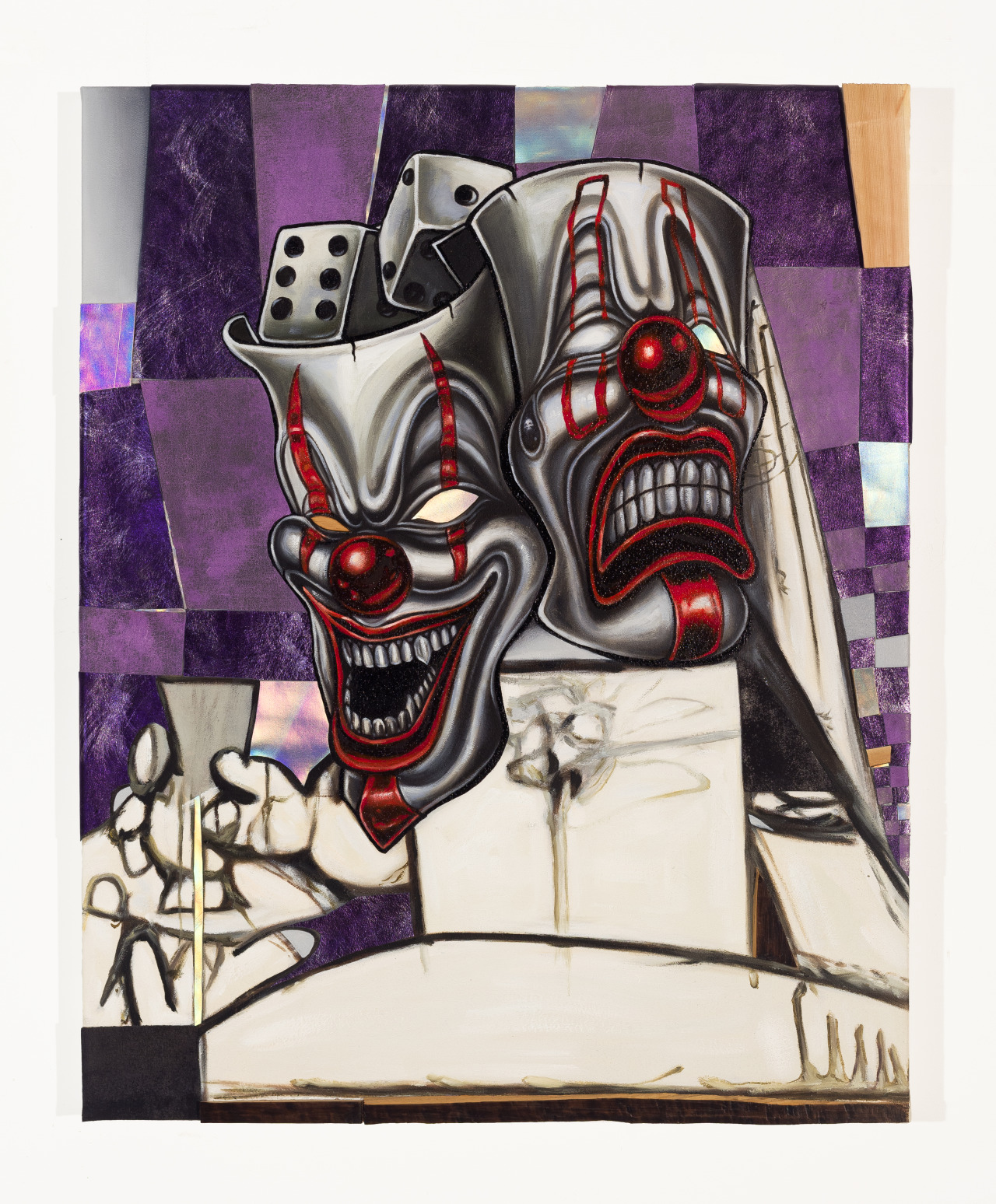
Edgar Serrano, Old Brown and Jaded, 2021, 30 x 24 inches, Oil, leather, and wood on canvas
This hinge point is interesting in relation to some of your newer work, which incorporates pop cultural imagery based in Latinx culture, including photorealistic depictions of cholos, clowns, masks, and low-riders, with art historical references, abstract forms, and materials such scrap leather and wood. What is it about the dynamic between these elements that appeals to you?
We are all molded by our environment, more so when we are young. My early life seeps into the work. But I am not interested in replicating the conditions of my upbringing. Instead, I want to infuse these memories with my present self and contemporary issues. My hope is that these dichotomies of Latinx culture and art historical references that hinge in my lived experiences demonstrate my willingness to be open and vulnerable while also leaving room for subversion.
Regarding materiality, I use wood and leather to index a kind of Primitivism which I hope also subtly conveys issues of cultural power.
I am curious about the idea of Primitivism as it relates to Modernist Art that has appropriated artifacts, carvings, and images produced by ancient native cultures. Primitivism is of course a condescending term coined by so-called enlightened civilized Europeans to refer to the art of the “uneducated and uncivilized tribes of Africa and Latinx America.” The word Primitivism presupposes a lack of evolution in these cultures and the art that they produced.
I’ve been thinking about self-taught art as a kind of primitive mask that both obscures and refracts representations of the Latinx. The kind of contemporary “primitive” masks I am talking about can be found in stickers distributed in low-income communities via vending machines that are meant to appeal to young children. I am interested in how these images facilitate identity formation as these unflattering mass mediated images circulate stereotypes within and outside of Latinx culture. In contrast, my work attempts to use these images to construct subjects that contain their own complexities and agency.
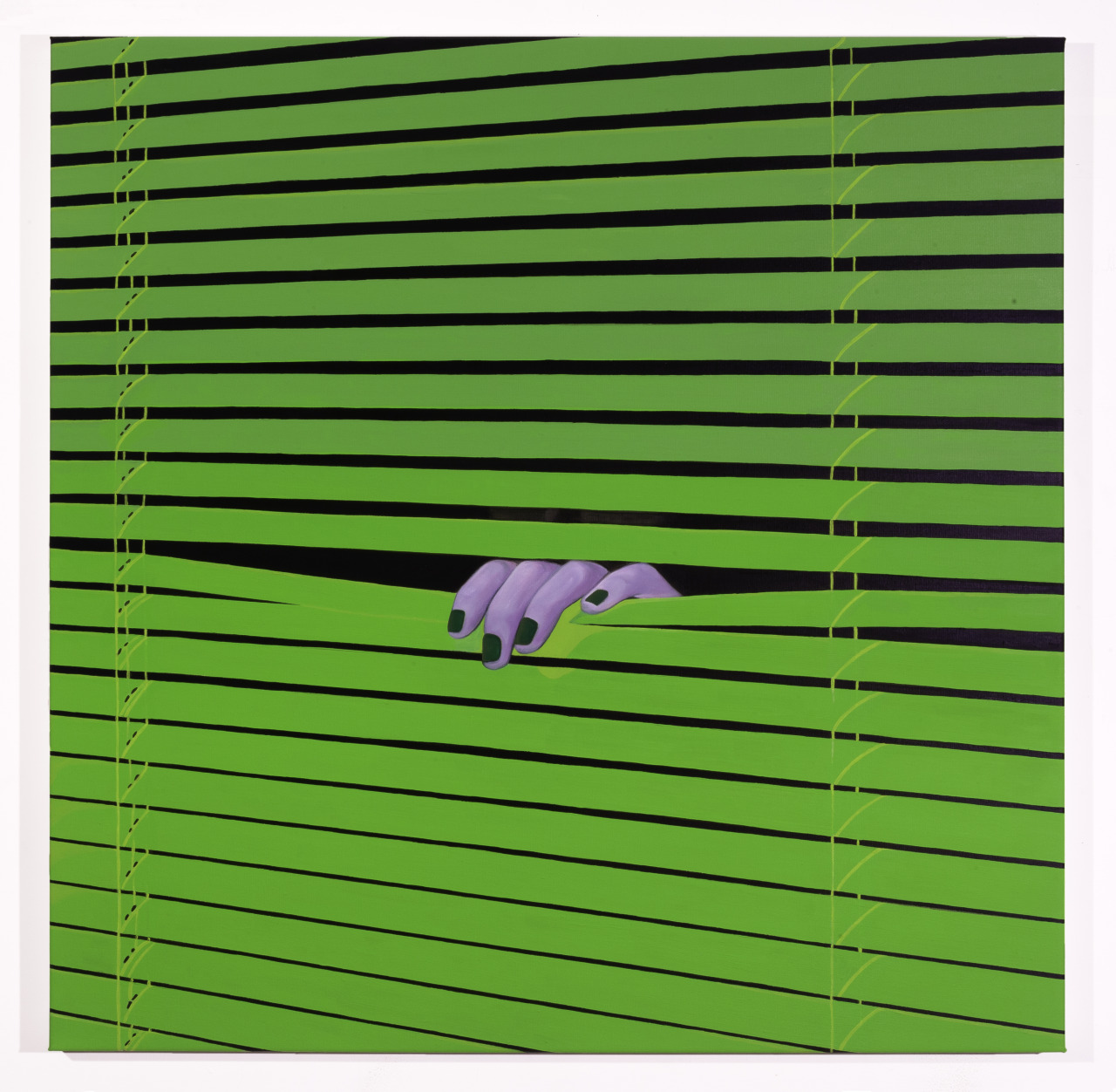
Edgar Serrano, Intruder IV, 2020, 36 x 36 inches, Oil on canvas
One of my favorite paintings (or series of paintings) in the show is “Intruder,” the first version of which appeared in your issue #25 zingmagazine project. What does this image of a hand pulling apart blinds signify to you? And why haven you chosen to make multiple versions of the painting?
For the “Intruder” series, I considered how the window has been used as a metaphor for painting: a transparent screen that offers a glimpse into another world. This series began with an image I found on the internet that I then digitally manipulated. Combining the metaphor of art as a window to the social imaginaries of xenophobia in contemporary America, the window also works as a metaphor for screen culture, translation, the flattening of information, and a border or boundary between worlds. I use the Internet as a window to an eternal present and intermediate space, separate from lived time; it offers me both a way to understand our present and a chance to see a future beyond oppressive traditions and hierarchies.
I also like to think of the window as a transitional space: It offers me both a way to understand our present and mirrors my own experience of existing in-between cultures as a Mexican American. I see the hands pulling apart blinds as abstract representations of humanity. Are we looking in or looking out?
The reason for the multiple versions is the limitless possibilities that are available by using digital image editing software. Also, my renewed interest or perhaps permission in seriality stems from recently reading, Van Gogh The Life by Steven Naifeh and Gregory White Smith and also The Andy Warhol Diaries. Both artists drew repeatedly from the same subject matter. Like a meme, this reliance on a single source opened the possibility to create endless and imaginative iterations from a single image.
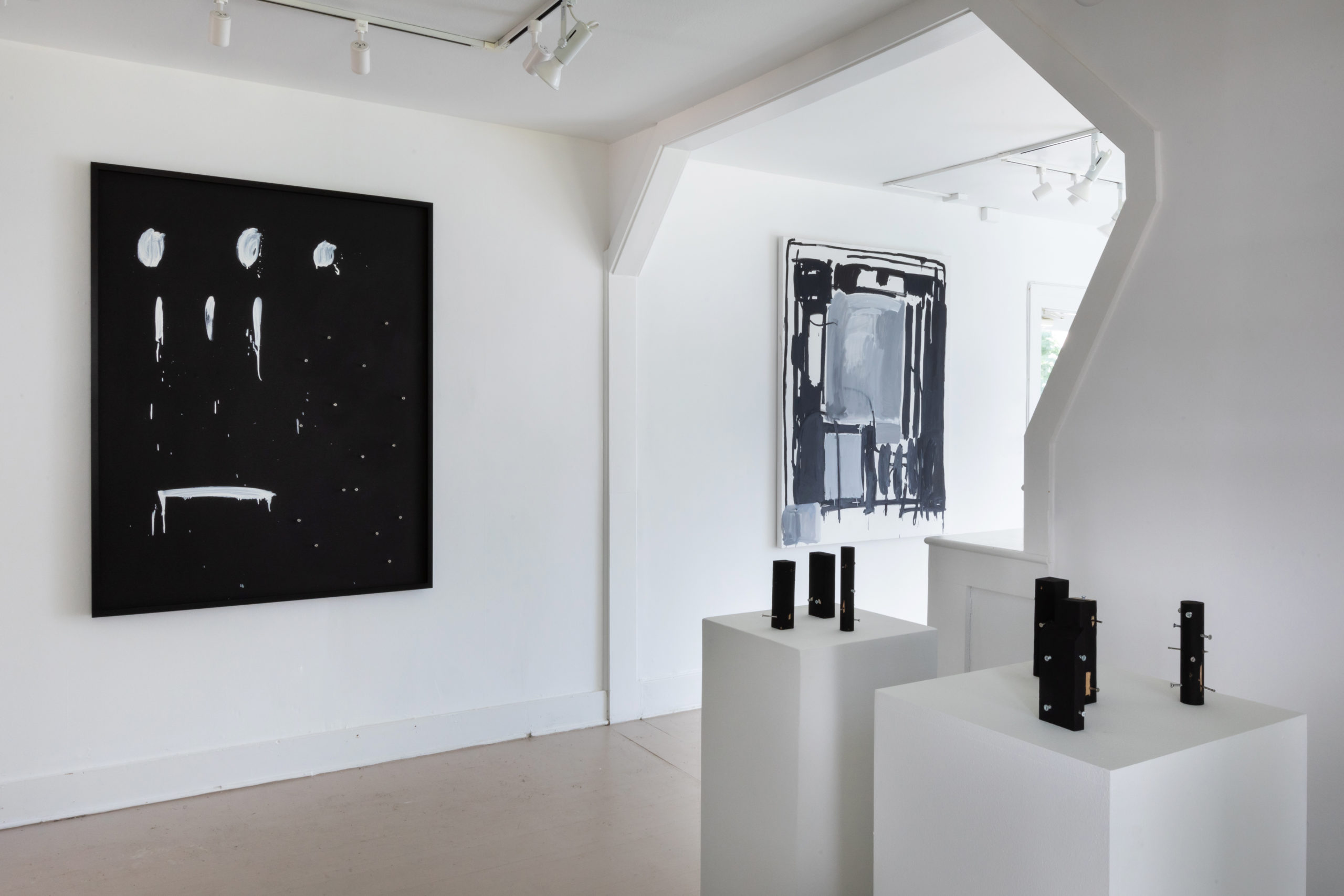
Installation view, courtesy of Jack Hanley Gallery
“Margaret Lee: Summer Discutio” on view at Jack Hanley, East Hampton, August 27 – September 18, 2021
Interview by Devon Dikeou
The title of your show “Summer Discutio” seems to open up conversation—root of discutio is discussion, but “discutio” also finds itself akin to shattered, strike down, dissipate which are the opposite of discussion. Could you talk about how the title and the word discutio effects and affects the reading and making of this recent body of work.
I came across “discutio” while reading an older text, although funnily can’t remember where specifically. While prepping for this show, I found a note in an older sketchbook where I had written the word very large and circled it, which meant I should look into the meaning. And yes, while looking into the etymology, I saw this contradiction which confirmed my wanting to make my new work with this contradiction in mind. My move towards abstraction was spurred on by wanting to sit with contradictions or seemingly oppositional forces. Very simply starting with black and white, 2D and 3D not through a “verses” lens but a relational lens or a reciprocal relation.
There is a very pared down palette and material use in the four paintings and four sculpture groupings, black, white, silver, gray (paintings) and wood scraps, nails, and screws (sculptures). No jars or loose change, disbanded rubber bands—that junk drawer described in the press release is curated and edited to a minimal amount of variants . . . Please elucidate on these decisions.
The process of narrowing down my choices is generally how I get to making a new body of work. I’ve never been drawn to the “everything is possible” fantasy but do think if consideration and care are applied to the given parameters and context, most things are possible. Conditions are always changing and so things in the past might not apply to today, so before I start working I take an assessment. Looking through my jumble jars/drawers is a simple, highly controlled, low-stakes mental exercise in assessment. Rather than tossing the whole lot out at once or using it all at once, I dump it out and see if things start to click with the ideas I’m mulling over. In this case, it started with scrap wood. The off-cuts were already all the same size creating an instant grouping without me having to decide scale. The uniformity of those pieces of wood informed my decision to stay rigid in my pallet and material use. It is always a relief when the materials give directions so clearly.
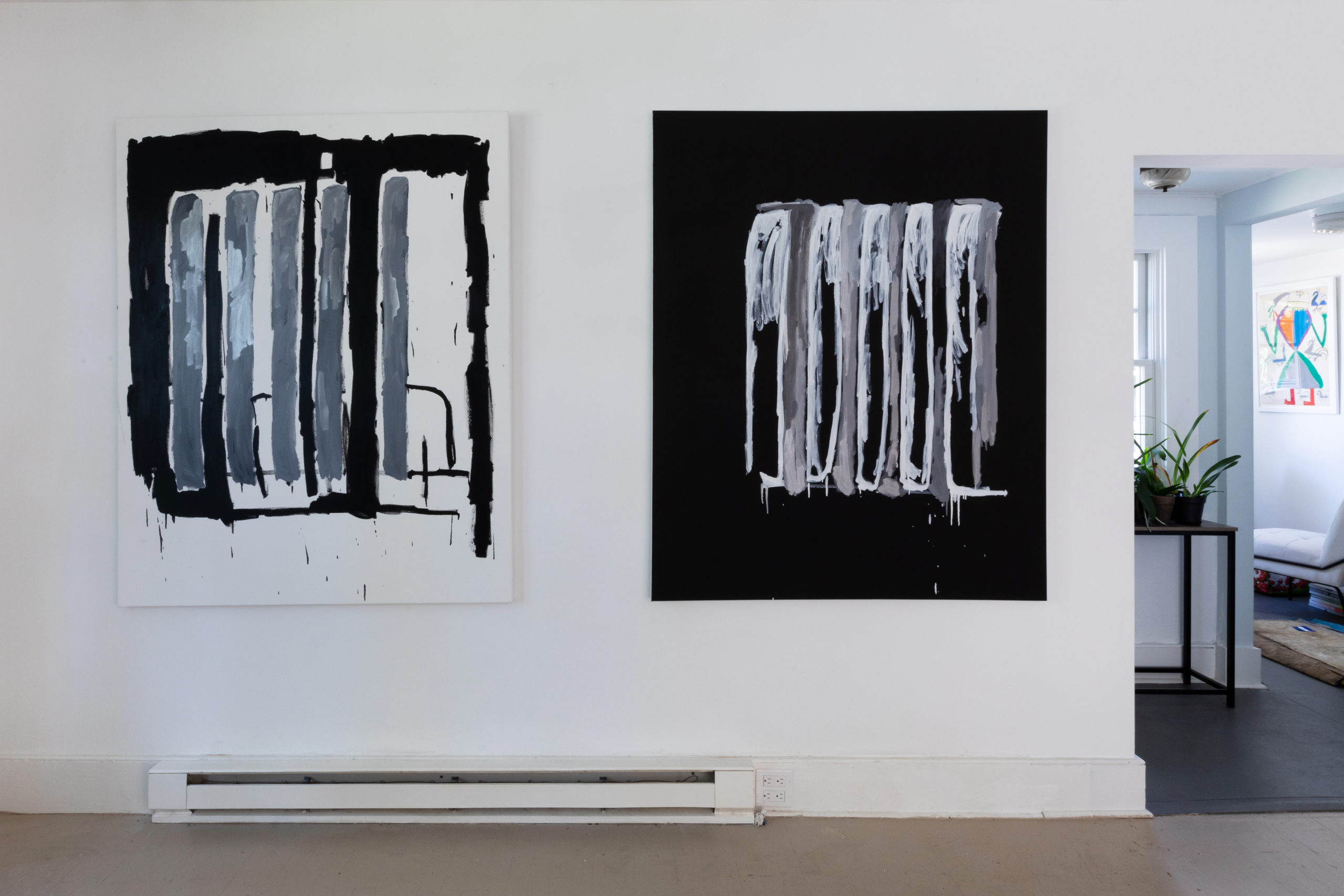
Margaret Lee, Discutio #1 & 2, 2021, courtesy of Jack Hanley Gallery
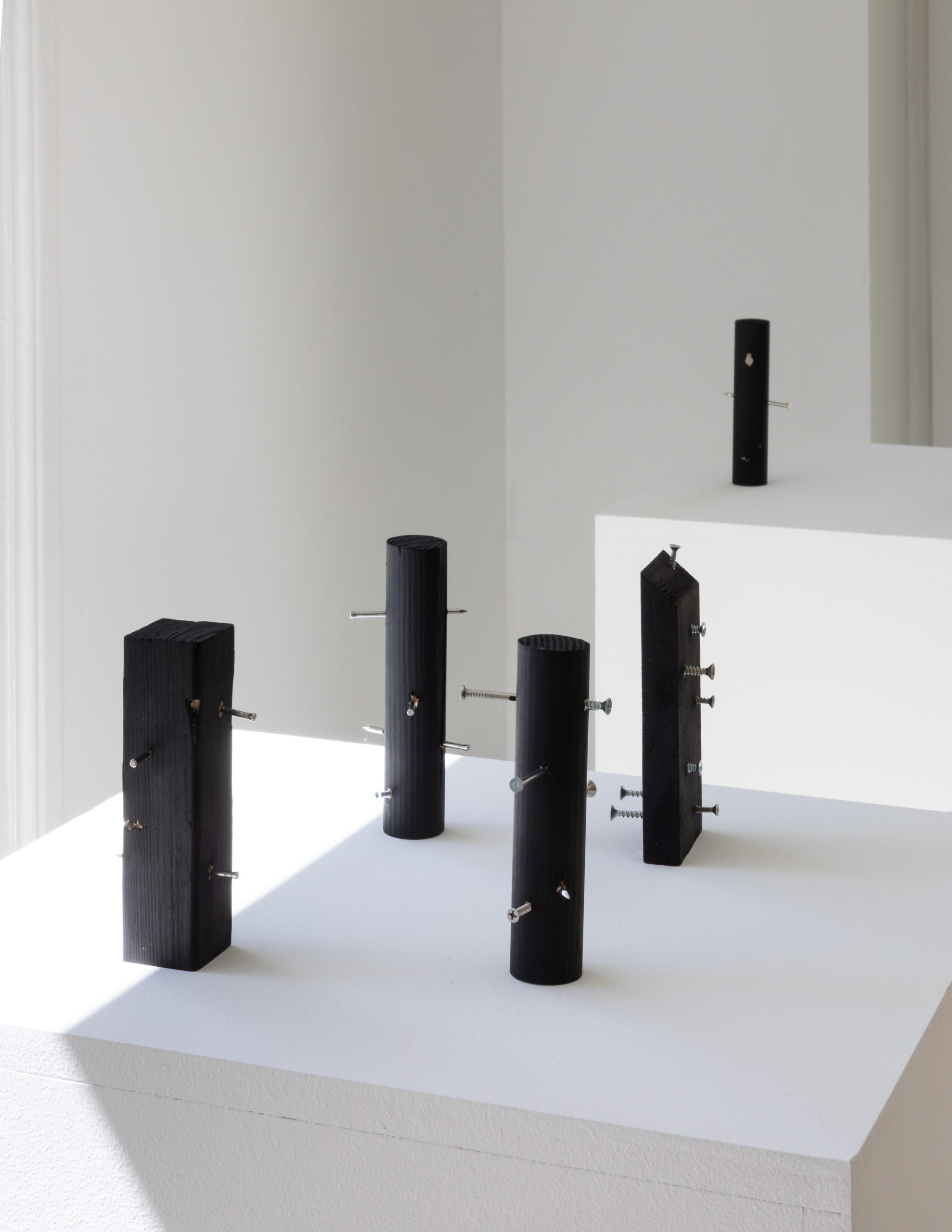
Installation view, courtesy of Jack Hanley Gallery
Previous bodies of your work take on/cite artistic movements, trends, practices as varied as the Pictures Generation, Surrealism, outright trompe l’ouille, even collage. The work in “Summer Discutio” is more staid . . . I feel like it’s channeling some era, a summer era oft thought of in terms of the Hamptons, as so many ab ex or action painters called the Hamptons their studio/home. Did locale have any influence on the work exhibited . . .
It’s hard for me to separate the location from its history and from its present form and I have mixed feelings on both, as I’ve had mixed feelings about all the other movements/trends I’ve cited previously. There is so much romanticism around painting and especially painters who have left the city. That narrative often ignores or erases previous histories as well as privileges the singular genius mythology. When given the opportunity to exhibit my work in a very specific context that perhaps I’m not 100% comfortable existing within, the process of conceptualizing, honing down ideas and the actual making of the work helps. I don’t feel the need to make that extremely personal process explicitly legible within the works themselves but hopefully materiality, form, palette and repetition come together to convey not resolution but an expanded inquiry, which I hope continues indefinitely.
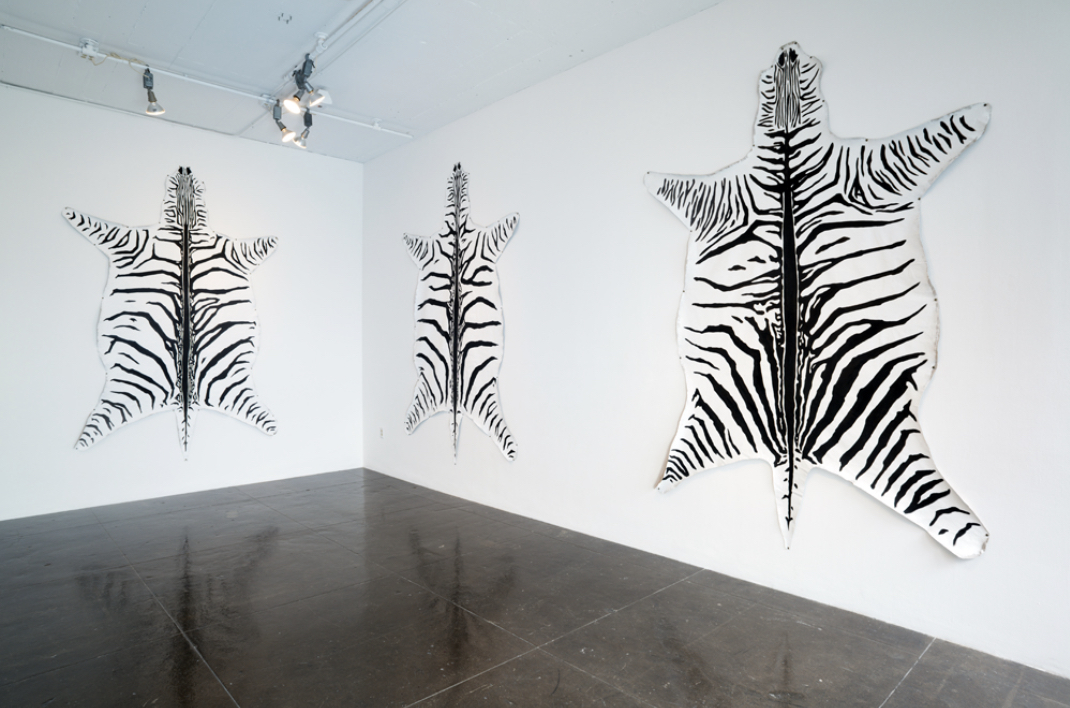
Margaret Lee, Zebra (Huh/What), 2009
So this idea of context in terms of studio practice and exhibition is of a personal nature, but there is some discussion/discutio that happens naturally between conception/execution and conception/exhibition . . . what about context when a work or body of work is collected. There an artist has no idea in what context their work will be exhibited or seen, or equally importantly, in the reading of their exhibition history present, past, and future. It’s an uncontrollable known, or maybe a controllable unknown. How does the work in “Summer Discutio“ relate to say specifically, the series in the Dikeou Collection, Zebra (Huh, What) 2009-12 . . .”
Those Zebra “paintings” are works I have consistently returned to as I make stretched paintings on canvas. I think when I made those works, I was trying to set certain parameters for how my work would be contextualized and what type of conversation the works would elicit. I wanted to question value and how it is created and the role of reproduction and authenticity within that process. The zebra acted as a ruse that allowed me to work with black and white paint without having to commit to or be placed within a Painting dialogue that I did not necessarily belong or wanted to be placed. Ten years later, I still committed to working with a limited and stark palate and less concerned with controlling context. Resigned and accepting discussion does not always result in understanding and consensus.
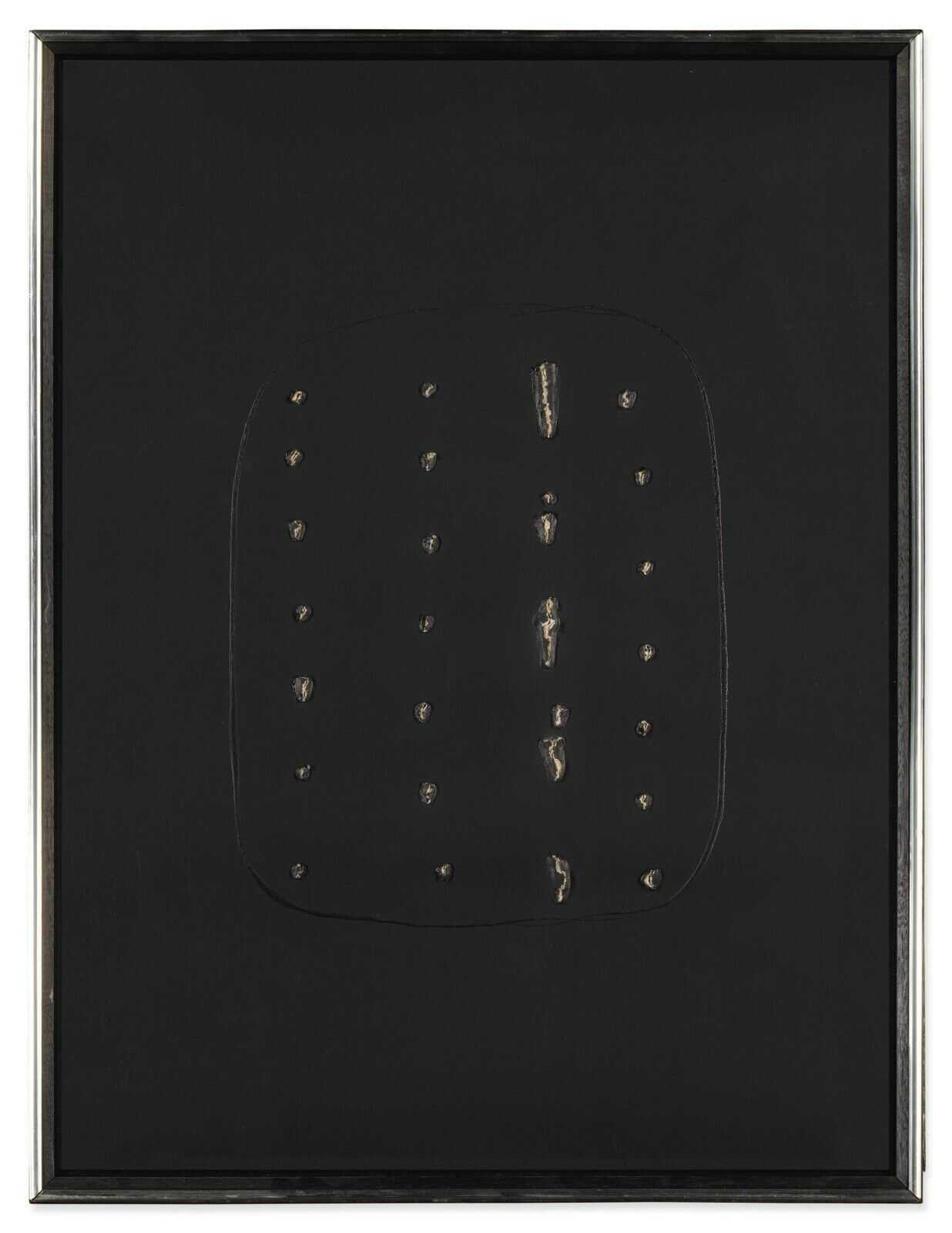
Lucio Fontana, Spatial Concept A (Concetto Spaziale A), 1968
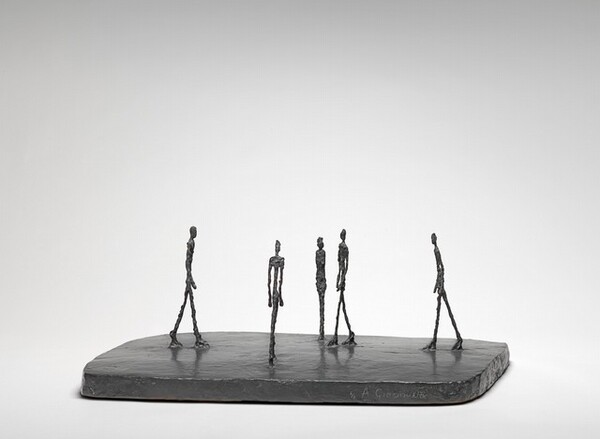
Alberto Giacometti, City Square, 1948
Pedestals, well they aren’t really that are they, plinths would be more accurate. How do these plinths interface with the work . . . of “Summer Discutio”. A perfect exhibition structure to present the imperfect . . . I kinda want to see one of those nails break the plane of the surface of the plinth that presents it . . . The same goes for the white cube gallery, which seems to be a cottage, and has cottage like cut out walls that follow the pitch of the house rather than the scrutiny of the white cube . . . And one of the wall hangings is referred to as sculpture . . . Very “Working Space”/Frank Stella-ish . . . Oh and Fontana . . . Screws certainly pierce the picture plane there . . . Thoughts . . .
I wasn’t able to do a site visit to the space before making these works but once they sent me a floor plan and photos, I realized the space felt somewhat divided in two, rather than a traditional white cube. This probably led me to wanting to include pedestal works to help balance the proportions between wall space and floor space. Whether or not I was successful, my intention was to seamlessly transition from the 2D painting surface to the surface of the sculptures. The paintings sit on white walls so I wanted the small sculptures to sit on an equivalent, which to me meant white pedestals. I definitely was thinking about piercing the plane, which was more easily achieved via sculpture than painting. I’ve been thinking about holes, punctures and the objects that get placed in said holes or do the puncturing for a few years now. I guess I’m still thinking.
Numbers . . . Three and four . . . Do they have any significance . . . In “Summer Discutio” . . . The groupings of both paintings and sculptures literally are in groups of three or four, often the compositions themselves in the paintings and sculptures favor groupings of three or four . . . I think I even count three or four windows . . . It speaks certainly of rhythm and balance, sometimes symmetry . . . Sometimes asymmetry. Are these threes and fours lonely soldiers or walking Congress in palazzos . . . Discussing or Discutio . . .
When I number my works, I think it’s in the mindset of getting one foot in front of the other, slow and steady, one step at a time, don’t get ahead of yourself. In my earlier work, I could set myself a task of making a plaster form look exactly like a watermelon. It was very obvious when the work was done and if the transformation was successful. With abstraction, it’s such a battle knowing what I’m trying to achieve and also knowing if I’ve arrived at the place I think I was trying to get to. Start with #1 and seeing how far it goes allows me to work without setting an overly ambitious agenda or thinking in grand epic proportions. But also, yes in regard to being in relation to the windows, I try not to fight against the space where I’m to exhibit new work but to allow the space to inform my decisions. And yes also to this idea that the works are talking or in discussion with one another, especially the sculptures. There is an internal dialogue between all the objects in the space, with each other and with the environment. It would be impossible for me to transcribe into words all the back and forth that is going on but also maybe that’s not the point.
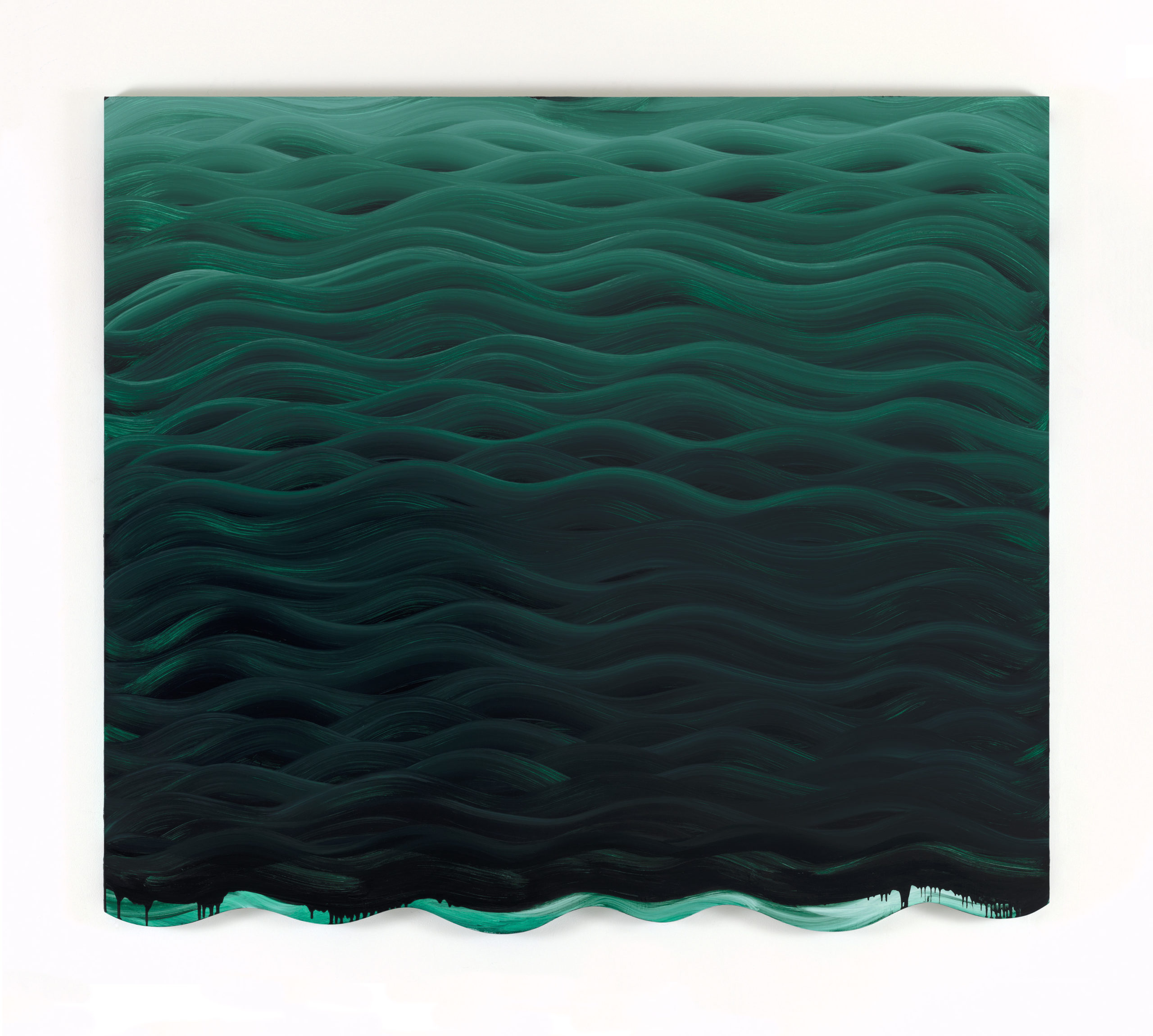
Karin Davie, While My Painting Gently Weeps no 2, 2019, oil on linen over shaped stretcher, 74 1/2 x 84 inches. Courtesy CHART, photo: Spike Mafford.
Karin Davie, originally from Toronto and now working between Seattle and New York, is a painter responding not only to the history of the practice preceding her time but also to her personal experience in the world. She was awarded the John Simon Guggenheim Fellowship Award in 2015 and was the subject of a major retrospective at the Albright-Knox Museum, Buffalo, in 2016, along with other institutional exhibitions both nationally and internationally. Her curated project
“Pushed, Pulled, Depleted & Duplicated” (with a poem-forward by John LeKay) appeared in issue #19 of zingmagazine. Davie’s solo exhibition “It’s A Wavy Wavy World” is on view through October 30 at Chart Gallery in Tribeca, New York.
Interview by Brandon Johnson
Upon entering the gallery I was met with two large scale paintings “While My Painting Gently Weeps No 2 & 4”. Each was immediately reminiscent of the surface of a moody and foreboding sea, which speaks to the title of this exhibition “It’s A Wavy Wavy World”. Did your thinking around the show change at all with the recent prolific flooding that occurred in New York as a result of the rainfall from Hurricane Ida?
The weather has become so unpredictable and dangerous because of global warming—but no, I didn’t think about this recent event in terms of my work. The imagery in these paintings comes from a deep ongoing interest in the history of art, the language of painting, issues of gender, identity, the body and landscape. My work doesn’t come from a reflexive reaction to something current in the news cycle. It’s a distillation of things that come from past and present history and my own lived experience. If I am drawn to some experience or idea, or am inspired to investigate something I don’t understand, these may develop enough urgency to make a painting. Things enter the work through a kind of osmosis. It’s filtered through my engagement with the world, sometimes pleasant, other times upsetting or enraging, and this takes time.
I currently live in Seattle, Washington. When I travel to my studio over a floating bridge which stretches across Lake Washington, I study the color and movement of the water and how it changes depending on the light and reflections. This experience of being surrounded by water, is an amazing sensation. I’m sure it has influenced my work. But I should also say, that water has an effect on me not only as an observed phenomenon, but as a metaphor for the forces of flow, unpredictability, transparency, the emotions, among others.
Moving further into the gallery there are four paintings featuring white squares in the middle surrounded by wavy brushstrokes and color gradients of blue, green, violet, orange and yellow. The former made me think of being underwater and looking to the surface light, while the latter resonated as cosmic or even supernatural transitory passageways, birth canals or “the light at the end of the tunnel.” Are these references on the mark, and how did you decide on the color palettes for these four paintings?
All the square paintings with intrusions have a slightly sly and humorous relationship to the metaphysical “light at the end of the tunnel” image. I wanted to play with this idea, and connect it to Minimalist painting, which is self-referential, emphasizing the medium and object-hood of the canvas, over a reflection of the outside world. These paintings push right up on representation and depictions of the body. This work is also rooted in personal experience, engaging with ideas about the self and identity. It’s a mash-up or smash up depending how you look at it (laugh). To me, they look like many things that convey transformation. For some paintings, I had a clear idea from the start what the color was going to be—certain hues of watery blues, hemoglobin reds or chlorella greens, for instance. I start by mixing up those colors, but the process allows for intuition. It’s not taken directly from observation or straight out of a tube. It may have origins from things I’ve observed in the world, and has to feel specific, but expands to involve organizing combinations of gradient colors to capture a mood or a feeling of temperature as well as creating optical movement, light and space in the painting.
In both cases, there is a primordial depth as relating to the sea (from which all life on our planet originates) and our own human watery origins of the womb. This is not only a space of physical abyss but also emotional, as watching the sea and contemplating our origins tends to have this effect. You’ve said the “wavy image” is a “recurring theme in my work and a metaphor for human emotions and life’s challenges–an obsession of mine.” Could you say more about this wavy image—as a symbol, a formal approach, and metaphor?
I can’t really tell you concretely why I’m compelled to paint waves or curving undulating forms, except to say that I’m driven to depict forms that relate to things in nature and the human figure. Geometric shapes contain and oppose this organic form. Perhaps we’ll find out in the future that these attractions or obsessions are all based on biology and genetics. Waves, by definition, are a disrupted transfer of energy and an action. The wave imagery can be metaphorical, but it’s not necessarily a thing itself, it becomes both a thing and an action when I paint. In my work an apparent landscape can morph into a bodily function or contour. It is this kind of “waviness” that is central to my expression. I’m engaged with the paint as a material and manipulate it into what I need to convey. My expression is embedded in the formal language of painting. In this particular work, it manifests in fields of wavy strokes in seemingly antagonistic relationship to the shaped format. It’s challenging and satisfying to work within this tight but limitless conceptual framework. These paintings have kinetic energy both optically and physically. These waves are essentially energy—they can destroy, or rejuvenate, possess darkness or light.
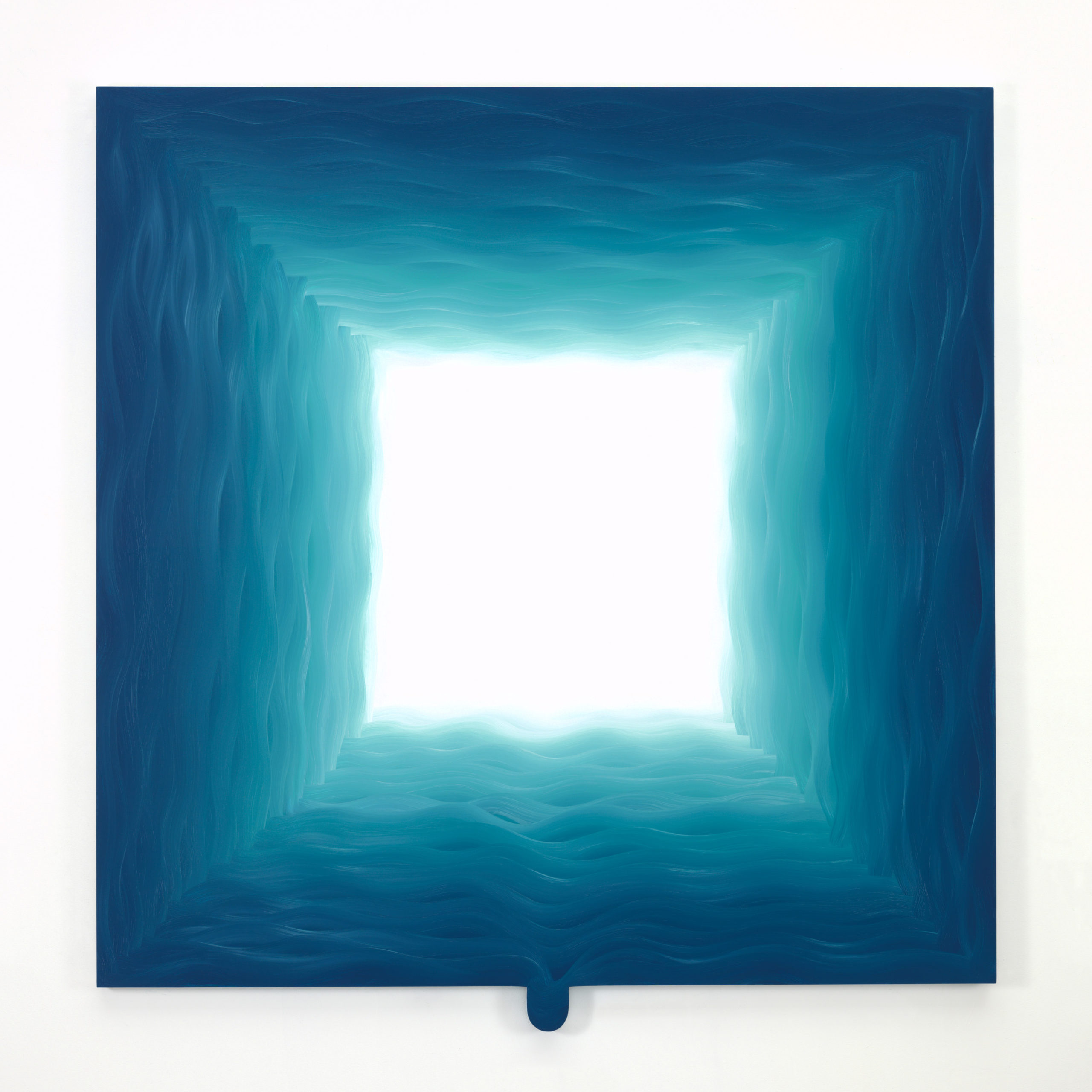
Karin Davie, In the Metabolic no 3, 2019 oil on linen over shaped stretcher 75 3/4 x 72 x 1/2 inches. Courtesy CHART, photo: Spike Mafford.
Many of the canvasses are shaped. What went into this decision? I’m particularly interested in those small semi-circle notches or extensions found at the bottoms of the In the Metabolic paintings…
When I first started this recent work, making wavelike marks around the inside edges of a large square, I observed my other hand securing the paper. I liked how the fingers appeared to become a part of the image, so the first drawings included a cut-out thumb shape intruding or protruding into the square. In both the drawings and paintings, the illusory image accommodates to the shape of the stretcher bar created by perverting the square. These first images led to other formal interventions determined by the shape and scale of different body parts or the canvases themselves. For instance, in the paintings “While My Painting Gently Weeps” and “Shape of a Fever” or “Down My Spine” the bottom or side shaped edges function like a cartooned version of the wavy strokes, which sets up a slight discontinuity. They purposely don’t exactly replicate each other’s form. In these works, the painted image is not co-extensive with the canvas shape, but is not unrelated to it either. It suggests a give and take of uneasy harmony with no easy answer over whether the literal or the pictorial has the upper hand.
The works on paper were made 10 years prior to the paintings. What led you to revisit and expand this body of work?
The large gouache drawings in the exhibition were made before the paintings, which is unusual for me. I don’t normally make comprehensive works on paper first. I see drawing and painting as conceptually linked but different enterprises. My process is that I make hundreds of doodles in sketchbooks, like automatic writing. Sometimes, I see an image in my mind, like hearing a song in your head, and then I quickly get it down as a doodle. If something interests me further from this process, then I will proceed to painting, sculpture, etc. But the paintings have a life of their own and everything still has to be worked out in the actual painting. This can take several years, as it did in this case. Things kept changing and shifting. It took a few years to settle on the scale and form. Although the gouache drawings in the show provided a foundation for these paintings, there were many steps in between. The materiality of oil paint differs from gouache, and the scale of the drawings differs from the paintings. This changes our physical interaction and perceptions about the image.
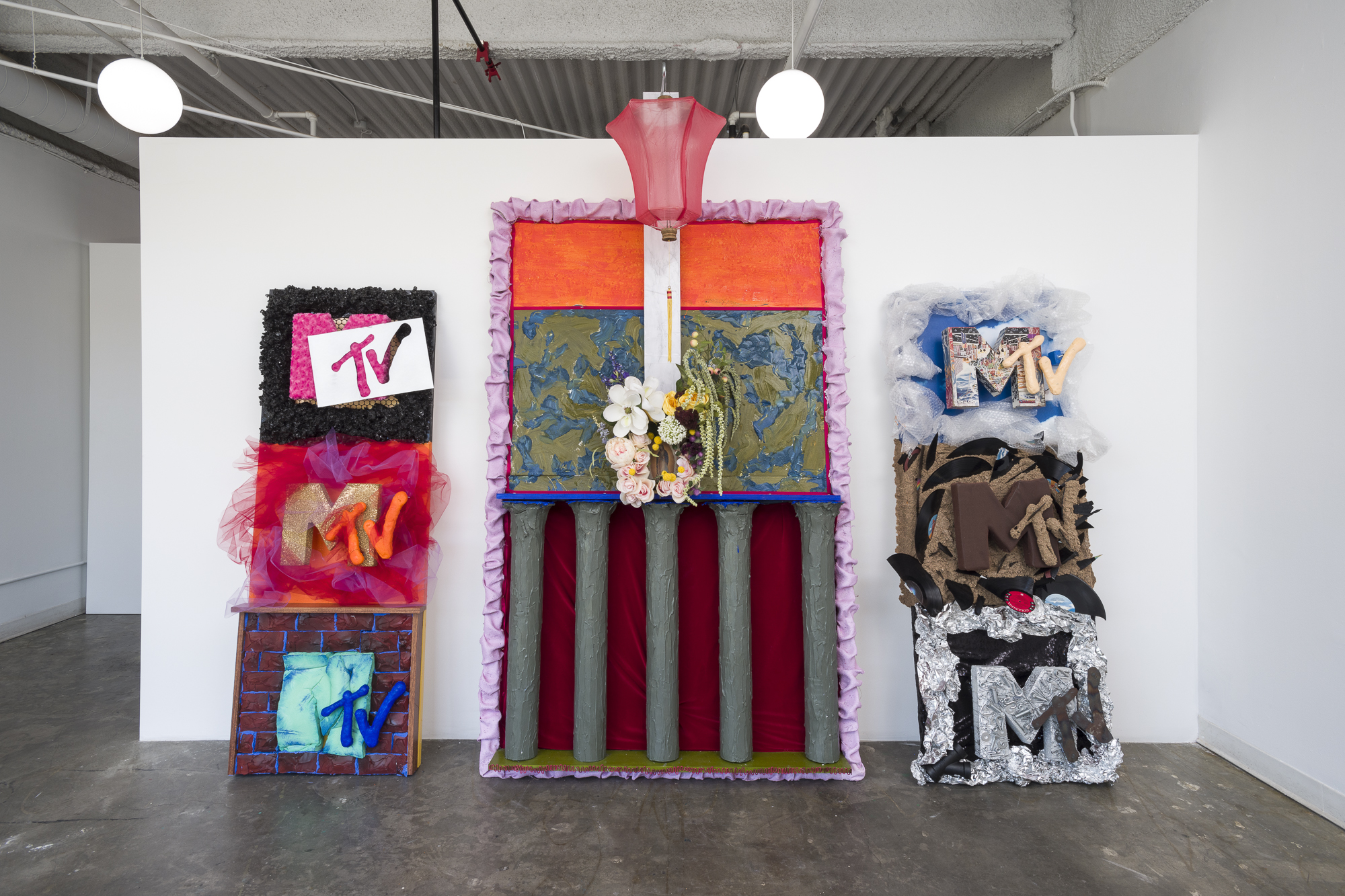
Rainer Ganahl and Devon Dikeou speak about Dikeou’s recent show “MTV Altarpiece” at Foyer-LA, an artist run space in Los Angeles, founded, operated, and curated by artist Connie Walsh. Concurrently running at The Dikeou Collection is Dikeou’s Retrospective, “Mid-Career Smear.” Both exhibitions are addressed. MTV Altarpiece closes July 31.
Interview by Rainer Ganahl
How do you feel showing one of your earliest pieces, made in 1986, for a third time? You also included it in your retrospective in Denver at the Dikeou Collection.
Showing the same work three times, MTV Altarpiece (1986 ongoing) and one image from Please (2011 ongoing) at Foyer-LA is not unusual and is part of my and many other artists practice and process, hence the “ongoing” cited in the dates in my titles. The ongoing process allows for reconsideration, re-examination . . . Originally, MTV Altarpiece was created for my thesis show at Brown and at that time MTV was at the nexus of its cultural influence . . . videos were no longer a visual illustration of a popular song featuring a band . . . The video WAS the song . . . This medium changed how music—an aural medium of music listening became a visual medium, one of watching, and how MTV profligated that change . . . And beyond musically. It was the cultural zeitgeist, the channel that caught and channeled literally how we consume culture—music and otherwise. MTV, the logo of certain period of time, was the sign, the symbol, the in-between platform representing music and all that comes with music as a visual metaphor. Now that sign, MTV, and that logo, that thing we think of associated with the letters, means different and other things, but still remains a sign, maybe even more of a sign. And the audiences have culturally shifted, and that recognition may land in the realm of nostalgia . . . It may land in the realm of MTV’s own cultural prescience.
Perhaps that is now why two different curators were so attracted to MTV . . . Cortney Lane Stell, the curator of my retrospective, Mid-Career Smear, at The Dikeou Collection, was insistent that MTV Altarpiece be recreated . . . So it was, and is displayed at The Dikeou Collection Pop-up. The Pop-up is in the old abandoned Jerry’s Record Shop on East Colfax . . . And Jerry’s was the epicenter of the Denver Music scene. Now it is a space which houses a collection of approximately 15,000 albums and is replete with all the trappings of the Jerry’s Record Shop scene, grunge, graffiti, vinyl . . . MTV fit in perfectly. Connie Walsh, an artist/curator happened to be in town and she visited MCS, keen on visiting both spaces (California and Colfax), despite her small pocket of time. In fact, I think she’s one of the few who saw both iterations of MCS at the time. Anyway, she has created a vibrant space in LA adjacent to her studio called Foyer-LA. Foyer, by definition is the room before, the room you enter, the segue that leads you in. As an exhibition space she gives that space a voice and gives the audience a preview . . . MTV found another lifeline in her space . . . So the three, 1st destroyed because it was held together with a glue gun, a tape gun, and staple gun, shown to a small audience in Providence in 1986, the second recreated for a thirty plus year career in Denver, the third a splash in Foyer-LA . . . And that last splash also includes a diminutive photo from my exhibition “Please”. . . A still life of a bouquet of flowers (Lilas et Roses, 2011 ongoing) after a series that Manet painted while dying of syphilis . . . A swan song . . . harkening back the heart of the altarpiece, the flowers in the MTV Altarpiece.
Since we are talking about your MTV Altarpiece, we must talk about the most effective distribution of music and the revolution music videos brought to people around the world. Do you think that the music got any better—we know for sure more people got richer?
I am not really much of a music anything so my reflections on it as an industry/critic won’t give much insight to anyone. The distribution probably worked like the radio . . . payola . . . But I am even less equipped to comment on that . . . I’d wanna “phone a friend” and that friend of a friend would be Sasha Frere-Jones. Beyond that, the reason I was so fascinated and still why the work holds resonance is because MTV has become more than a platform, it has become a sign . . . It is a world recognized brand like Nike, Coca-Cola, or . . . Apple. It changed our lives and how information is processed. MTV brought us more than just music . . . The first Reality TV program, The Real World, and the first death of an “Reality TV Actor” on The Real World of AIDS—the Young Vote became an important recognizable voting block leading to the Clinton Presidency, to name a few of MTV’s cultural implications . . . Whether MTV does so now is . . . Well their logo and award statue reached for the moon and literally the MTV logo has a space ship taking off as its electronic jingle pulses . . . Branson, Bezos, and Musk make good on that space bet . . .
What is your current taste in music (and why not include art in this question) and how do you think music and art and their distribution look in another 35 years?
Someone referred to a mountain radio station here in Colorado as the ’80s prom night station . . . Music does play a part necessarily in the reading of the artwork, but maybe so do John Hughes movie soundtracks . . . Which basically a Hughes movie is an MTV movie . . . In that vein, I made a playlist for the MCS, choosing songs for each piece in the exhibition, that in some sense, reflect the artwork. MTV Altarpiece’s song is “Pour Some Sugar on Me” the Def Leppard ballad that aired based on paid, call in, phone requests every day for a record run in the ’80s—all before Carson Daly’s Total Request Live . . . You access the MCS songs with your iPhone . . . It’s free.
I am curious about the aesthetic of MTV Altarpiece. To me, compared your other work, it looks really “trashy” and punk and incorporates a lot of the cultural tokens over which the American Culture landscape is still fighting. In particular when it comes to question of the incorporation of signifiers that some so-called minority immigrant communities want to claim solely for themselves?
MTV Altarpiece is not very well put together . . . At the time there was no conservation term for it, like “inherent vice,” in which the material something is made of, by its own materiality breaks down the whole conservation process and the piece itself . . . Like Lizzi Bougatsos’s ice sculpture (Self Portrait, 2012, The Dikeou Collection) . . . MTV is thrown together, but it is also reflective of the punk, trashy way graphics, videos, art, music were visually implemented in the ’80s, using color xeroxes, quick cuts, colors from spray cans . . . Packing materials . . . So yes, it’s look must seem more trashy, punk . . . I am not interested by a white cube aesthetic and throughout all spaces I exhibit, I try to challenge that aesthetic. In the California St space (MCS) all the holes in the walls of the Dikeou Collection remain, as ghosts of what’s been before, as do certain Collection pieces. In the Pop-up—that it is a record store reflects very much the place and atmosphere of MTV. At Foyer-LA, that it is an artist run space and grew out of an artist’s studio, and is a resting place to exhibit art in proximity to the studio reflects this idea, of the breakdown of the white cube, and makes and shakes ideas of what and where a gallery is and can be . . . It makes sense that this breakdown happens outside of New York, as historically this breakdown happens outside the epicenter and that it reaches more than just the art community . . . I think more along ideas of flatness, than in terms of tribe . . . How that translates among diverse communities and markets becomes more about fighting and/or absorbing the natural market mechanisms. The minute something is free, the market finds new ways to commodify it . . . Napster and Video Art in their initial stages, and more contemporaneously streaming and NFTs . . . Initially streaming was free TV and digital art, free art . . . Now there are streaming subscriptions for CNN and Discovery . . . So you pay for and get more specific and curated streamed content, or you pay for a specific moment, a zeitgeist moment, in an explosively priced NFT . . . Come to think of it CNN and MTV originally began as subscriptions in the ’80s . . . Buyers and subscribers beware.
I am an artist who does so so many things, I have invested nearly all my life in questions of class and race and politics and I still wonder who should say what to whom and under what conditions . . . And with a body of work to reflect that as varied as performance, videos, paintings, drawings, fashion lines, ceramics, multiple web sites, I needless to say, have very little means to even store a piece like this over such a lengthy period of time. Could you tell me how you did it ? Did you simply remake it, redo it from scratch or could you just pull it out of storage?
There’s a great documentary called “Scratch”, by Doug Pray. It’s about the history of DJs . . . ’70s to 2000s. And what is a DJ . . . They take a given and make something out of it . . . They spin . . . So yes, it’s made from scratch . . .